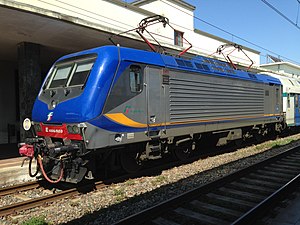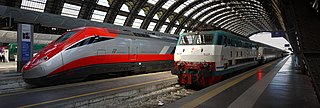
The Italian railway system is one of the most important parts of the infrastructure of Italy, with a total length of 24,227 km (15,054 mi) of which active lines are 16,723 km. The network has recently grown with the construction of the new high-speed rail network. Italy is a member of the International Union of Railways (UIC). The UIC Country Code for Italy is 83.

The FS E.645 and E.646 are two classes of similar electric locomotives used on Italian railways. They were introduced during the 1950s and they were retired in 2009.

The E.412 class is a batch of multi-role electric locomotives built for the mountain lines, particularly for the northern Italian lines of the Brenner pass. They are known as Brenner or Brennerlok locomotives. 28 units from both the groups have been acquired by Trenitalia, as part of a process of simplifying rail operation between Italy, Switzerland, Austria and Germany. The locomotives are qualified for running on French rails, too, making the E.412s potentially fit for service on most European lines except the high-speed rail lines.

The FS E.636 is a class of Italian articulated electric locomotives. They were introduced in the course of the 1940s until the 1960s, and have been decommissioned since 2006. They have been one of the most numerous Italian locomotive group, and have been widely employed during their long career, hauling every type of train, ranging from freight to long range passenger services. Their introduction also saw the employment of some revolutionary design concepts, such as the articulated carbody and the three bogies scheme.
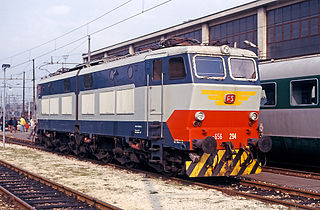
The Class E.656 is an Italian articulated rheostatic-type electric locomotive built from 1975 to 1989. An evolution of the E.646, they are mixed traffic locomotives, and have been used on every kind of train, ranging from freight to intercity passenger transport.

The FS E.444 is a class of Italian railways electric locomotives. They were introduced in the course of the 1960s until 1975. Starting from 1989, all E.444s were upgraded as E.444R.

The FS E.632 and E.633 are two classes of Italian railways electric locomotives. They were introduced in the course of the 1980s.

The SNCF Class BB 36000 locomotives are a class of triple voltage 4 axle twin bogie electric locomotives built by GEC-Alsthom between 1996 and 2001 for SNCF.

E.402A/B is a class of electric locomotives mainly used on medium speed passenger trains by the Italian railway company FS Trenitalia.

The FS Class E.550 was a class of three-phase electric locomotive used in Italy, introduced in the 20th century, which remained in service until 1965.

Line 2 is a rapid transit service operated by Trenitalia in the city of Naples, Italy. It connects 12 stations.

The Transnet Freight Rail Class 19E of 2009 is a South African electric locomotive.
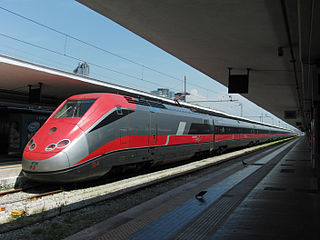
ETR 500 is a family of Italian high-speed trains built by AnsaldoBreda and introduced in 1993.

The FS Class E.405 is a class of electric locomotive built in 42 units by ADTranz originally for the Polish State Railways (PKP), but later acquired by Trenitalia Italian state railways.

The ALe 582 is an Italian electric multiple unit train designed for commuter and medium-distance services, developed in the mid-1980s to replace pre-war and immediately post-war EMUs and locomotive-hauled trains on various lines in Sicily and Southern Italy, although they later diffused on the whole FS network. They're part of the "ALe Elettroniche" or "G.A.I." family, together with their predecessors ALe 724 and their successors, the ALe 642.
The FS Class E.470 was an electric locomotive class of the state-owned Italian railway Ferrovie dello Stato. It was used on the Italian three-phase test line from Rome-Sulmona especially in express train service. After the end of the trial operation in 1945, the locomotives were scrapped, and no locomotive of the class has been preserved.

The FS Class E.431 was a class of three-phase AC electric locomotives of the Italian State Railways (FS).

FS Class E.432 was a class of three-phase electric locomotives of the Italian State Railways. Forty of these 1′D1′ locomotives were built in 1928 by Società Ernesto Breda and two have been preserved.
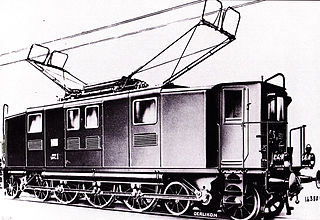
FS Class E.332 was a class of three-phase electric locomotives of the Italian State Railways (FS). They were used for the haulage of passenger trains between 1917 and 1963. Designed and built at the same time as the FS Class E.331, they represented an attempt by FS to extend the use of three-phase AC electric traction from primary to secondary routes. Their performance was disappointing and they were relegated to a marginal role, in which they remained despite several modifications.

FS Class E.333 was a class of electric locomotives of the Ferrovie dello Stato (FS), powered by three-phase alternating current, which were in service from 1923 to 1968. They were designed by Kálmán Kandó for hauling fast passenger trains. Having the same electrical equipment as the FS Class E.552 locomotives, they presented the same defects and had to be modified. After modification, they were able to carry out the services for which they were designed.
